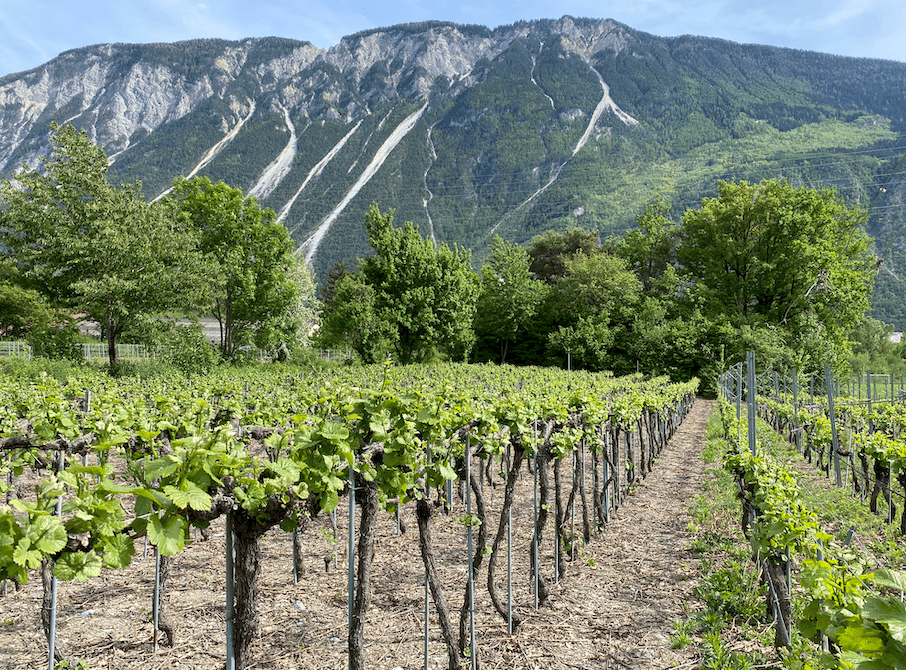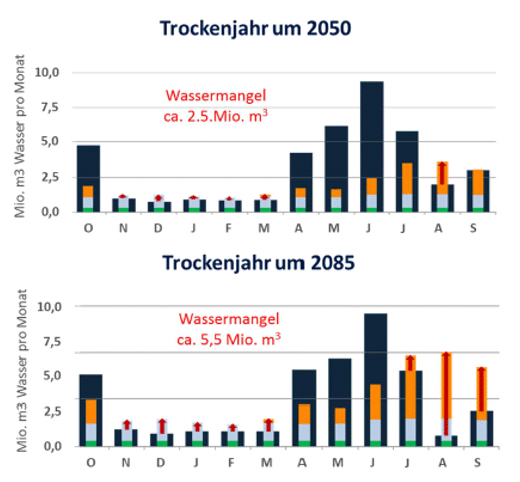Switzerland may be Europe’s “Chateau de l’eau” but even here the effects of a warming and unpredictable climate are biting. In the municipality of Salgesch (Valais) there is already an acute risk of water shortages, existentially threatening local agricultural production in the coming years. Now, the first-in-kind “Lienne-Raspille” project seeks to solve this problem of local seasonal water shortages, and serve as a blueprint for similar regions in Switzerland and globally.
Reduced snow and glacier melt
Just like California, Southern Europe and many other places, the municipality of Salgesch and its farmers rely on snow melt for irrigation in the summer, but this now runs out as soon as June. This triggers an acute shortage of water precisely when it is most urgently needed for irrigation.
This poses a massive economic threat as the municipality’s income is significantly based on agriculture, viticulture and the associated tourism. To make matters worse, if the dry vineyard areas in Valais are no longer used and irrigated, this would set off negative feedback loops. Evaporation and evapotranspiration – crucial influences on a regional climate remaining moderate – would disappear completely, thus precipitating a downward spiral.
Prize-winning technological solutions
In 2021, an ambitious project to remediate these issues was recognized by winning the annual PrixAlpiq, 12 years after it was first conceived by engineer Yves Rey. The following years Prof. Weingartner (University of Bern) conducted research around the idea, and with Walter Thut (AQUA4D) developed a specific concept for finally making this integral water supply project a reality.
Combining intelligent planning, hydroelectric power and irrigation technology, this project could completely change the outlook in the municipality, and act as a test case for similar projects. The combination of drip irrigation technology with the latest water treatment tech AQUA4D, produced nearby in Valais, combined with modern monitoring tools, could save at least to 40% of its previous water demand.
Integrated water management to benefit upstream water availability
With this project, the annual irrigation demand of Salgesch can be reduced from 436,000 m3 to about 262,000 m3. Today, the 10 municipalities of the planned network require on average about 6.5 million m3 of water per year for their total agricultural areas, so with optimizations for all of them, about 2.6 million m3 of water can be saved. The irrigation demand for the year 2050 is estimated at about 10.5 million m3, so a saving of 40% means a total saving of 4.2 million m3 of water per year by 2050.
The impact of this project could be stunning: a successful project at the community level has a clear signal effect. Other nearby communities would also want to optimize their irrigation networks, and nationwide implementation could ultimately result in savings of orders of magnitude.
On a global level, communities in similarly water stressed areas such as California and Chile will be closely watching developments. If the combination of municipal cooperation and high technology can work here, it can work elsewhere. With the realization of these large water savings and proof of concept, corresponding historical objections will no longer be upheld, and important future projects could be given the green light.
Sustainable development and reducing emissions
Many emissions associated with irrigated agriculture come from the energy required to pump water – especially uphill, as is the case here. With reduced water consumption comes significantly reduced energy use through less pumping – water savings of 40% would result in energy savings of the same order compared to today, and the associated emissions. This entails financial benefits too, of around 72,000 CHF.- (at 22 Rappen/kWh) per year.
Most stunningly of all, instead of Salgesch consuming energy by having to pump groundwater up the hills, the eventual expansion of this project will save water while producing hydroelectric energy at the same time thanks to better water availability in the upstream dam. This is a win-win: less energy consumption, and more renewable energy production.

Walter Thut at a pre-installation inspection of the site in Salgesch, May 2022.
Ecosystem and environmental benefits
Thanks to the water-saving measures and reduced water requirements, the upstream flaura and fauna will benefit too, with more water available in the increasingly expected dry periods, thanks to plans to fill the creek torrents during such periods.
The region’s environmental footprint will also be reduced, as a steadfastly strong viticulture will entail less imports of wine from other regions such as Australia or Chile.
Conclusion: proven technical feasibility, ready to implement
The technical feasibility of the project is proven, supported by the municipal government and the engineering firm Cordonier & Rey SA.
The first phase of the project, a demonstration on a field of about 1 hectare, will be fully financed thanks to the #prixalpiq first prize. This will guide to the next community-level stage (200 hectares).
If and when the above efficiencies and savings are achieved, other Swiss regions and water-stressed regions around the world will be watching keenly to see how this seamless example of integrated water management can be successfully replicated.
Switzerland
Water-Smart Agriculture
Precision Irrigation
In numbers:
Kick-off date: May 2022
Reduction in irrigation demand: 436,000 m3 to 262,000 m3
Potential water savings: 2.6 million m3 per year (present) / 4.2 million m3 per year (2050 projections)

Like many similar climatic regions worldwide, these wine growers rely on meltwater from snow and glaciers.

Graphs showing projected water scarcity in Crans-Montana (Valais) by 2050 + 2085.


